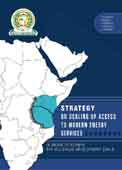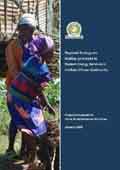| Case: East Africa - Scaling up Access to Modern Energy Services | |||
| |||
East African Community (EAC) Regional Strategy for Scaling up access to modern Energy services
Reviewed by Timothy
Byakola, CDI / INFORSE East Africa, Uganda
Background
The East African Community (EAC) is the regional intergovernmental organisation
of the Republics of Kenya, Uganda, the United Republic of Tanzania, the Republic
of Rwanda and the Republic of Burundi with its headquarters in Arusha, Tanzania.
Lack of energy access strategies poses a
major risk to the abilities of East African
Community countries’ to meet MDGs and reduce poverty. With a
population of over one hundred million people, energy “poverty” affects
all countries in the region. Traditional biomass (wood, charcoal and animal
waste) currently meets most of the regions’ household
cooking and heating needs. Diminishing of
biomass resources has reached critical levels
in the
region. This coupled with the rapid urbanisation,
has contributed to the increasing scarcity
and high price of cooking fuel in urban areas.
The East African Regional Strategy seeks
to engage EAC partner states in an ambitious
initiative to scale up access to modern energy
services to support
the achievement of the MDGs and poverty reduction.
The strategy is a plan to
meet the region’s energy and development
targets by scaling up new and existing business
models, leveraging development finance and
securing
programmatic
support to ensure an enabling environment
for increased energy access.
The objective of the strategy is to enable at least half of the population
to access modern energy services by 2015 i.e. 9.6 million households (Aprox.
48 million people), 23,000 extra localities.
The strategy also aims at the following:
· Reinforcing regional integration
by pooling good practices and exchanging experiences
for capacity building.
· Promoting harmonised political and institutional frameworks to include
energy access as a key national priority for
ensuring human development and achieving the Millennium
Development Goals (MDG).
· Supporting development of MDG based investment programmes.
Timeline
The strategy
was adopted by EAC Council of Ministers in November 2006.
In January 2009, a project document “Initial Implentation Activities“ was
published including a 24-month plan to implement the strategy with a budget
of US$ 3.2 million.
The final report document was preperad in June 2009 “Regional Strategy
on Scaling Up Access to Modern Energy Services in order to achieve the MDGs.”
Both reports were prepered by EAC with assistance from the UNDP and GTZ.
Different
Players
The EAC Energy Strategy will be implemented with various partners.
· East African Community countries
· UNDP, GTZ and the EU energy initiative have shown great interest to
support EAC in realising the energy access goals
· UN habitat has initiated a programme to improve livelihoods in poor
urban areas and human settlements. UN habitat is working with a
group of stakeholders to
improve access to modern energy services in poor urban settlements.
· WHO has developed technical expertise in the field of household energy
and health. The experience of WHO will be useful in generating
knowledge on the impacts of traditional solid fuel use.
· SIDA has been supporting rural electrification programmes in Tanzania.
Benefits and Impacts
The four EAC energy Access targets include:
Target No. 1: The strategy aims at introducing modern cooking practices for
50% of those relying on traditional biomass for cooking. Various options for
improvement include improved cook-stoves, biogas, liquefied petroleum gas etc.
Target No.2: The strategy aims to increase access to electrification of the
urban and peri-urban populations.
Target No. 3: Access to modern energy services for all schools, clinics, hospitals
and community centres.
Target No. 4: Access to mechanical power within the community for productive
use and heating for all communities.
The outcome will be that an additional 9.6 million households (approximately
50 million people) will have access to modern energy services.
The strategy will contribute to a reduction of net greenhouse emissions from
burning of traditional biomass, fossil fuels through the use of efficient energy
stoves, biogas and expansion of rural and urban electrification. The sale of
these technologies will contribute energy jobs.
Recommendations
· Build the institutional capacity of key public and private sector institutions
that will have regional impacts.
· Assist member countries develop investment programmes.
· Develop a Regional strategy to inform and support National strategies.
· Undertake comprehensive analysis of energy policies across the region.
· Remove barriers to expansion of access to modern energy services.
· Mainstream access to basic energy services within National planning
and budgeting processes.
· Develop strategies to build National capacity to support the role of
private sector and communities in enhancing effective energy service delivery.
· Develop pro-poor energy policies and strategies including financing
support programmes e.g. soft loans, grants e.t.c
· Identify and promote suitable models.
Financing the Strategy
The total capital expenditure to cover scale-up of existing and introduction
of new business models is budgeted to USD 2.7 billion:
· USD 1.6b end user contribution
· USD 1.1b subsidy by govt and dev partners
The support required to trigger capital expenditure is USD
556 million:
· USD 217m from dev partners programme support
· USD 291m loan guarantees by dev banks
· USD 48m from EAC
More information:
Timothy Byakola, CDI / INFORSE East Africa, Uganda.
www.inforse.dk/africa/CDI.htm and www.inforse.org/africa
EAC publication January 2009 (pdf) and Country Report and Implamantation Plans can be downloaded from www.energy.eac.int
 |
|
| Energy Access | |
| Contents Solutions to provide energy access for all Cases: |
|
| AFRICA | |
| · Kenya: Decentralizing Power Policy | |
| · Kenya: Afforestation for Charcoal | |
| · Mali: Jatropha Biofuel for Rural Electrification | |
| · Mali: Solar Lighting Kits for Rural Areas | |
| · Uganda: Feed-in Tariff for Renewable Energy | |
| ASIA | |
| · India: Solar Dryer | |
| · India: Solar Lantern Charging Station | |
| · India: Household Biogas Plant | |
| · India: Micro-Agroecological Village Development Model | |
| · Nepal: Improved Water Mills | |
| · Nepal: Charging Centre for Solar Lamps | |
| · Sri Lanka: Commercialization of Improved Cookstoves | |
| · Sri Lanka: Standard Code for Domestic Biogas Systems | |
 |
|
The
cases were collected in the framework of the "Southern Voices on Climate
Change" Project. Link: www.climatecapacity.org INFORSE-Asia and INFORSE-Africa |
|

